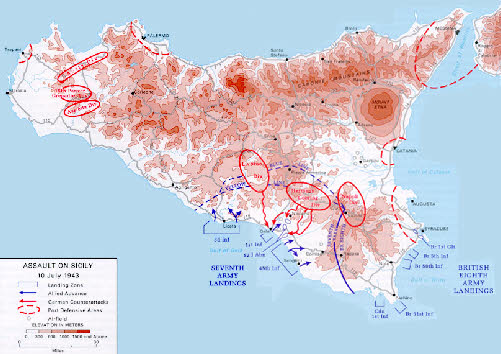

Rhine campaign
The Division was holding positions on the Roer when it was ordered to help contain the German Ardennes offensive. The Division fought in eastern Belgium, blunting the German Fifth Panzer Army's penetration of American lines. The Division helped reduce the Bulge in January, fighting in the Ardennes forest in deep snow, and cleared the area from Houffalize to the Ourthe River of the enemy. After a rest in February, the division drove on across the Rhine 27 March, and was the first American Division to reach the Elbe at Schonebeck on 11 April. It was halted on the Elbe, 20 April, on orders. In July the division entered Berlin-the first American unit to enter the German capital city.
During World War II the 2nd Armored Division took 94,151 prisoners-of-war, liberated 22,538 Allied prisoners of war, shot down or damaged on the ground 266 enemy aircraft, and destroyed or captured uncountable thousands of enemy tanks and other equipment and supplies.
In 238 battle days the 2nd Armored suffered 7,348 casualties, including 1,160 killed in action.
The division was recognized for distinguished service and bravery with 9,369 individual awards, including two medals of honor, twenty-three distinguished service crosses, and 2,302 silver stars,a few receiving the silver star was, Douglas MacArthur, Bill Bowerman, Hugh Armagio, and Stan Aniol as well as nearly 6,000 purple hearts.
The division was twice cited by the Belgian Government and division soldiers for the next 50 years proudly wore the fourragere of the Belgian Croix de Guerre.
World War II:
The 2nd Armored was formed at Fort Benning, Georgia on 15 July 1940, originally commanded by Major General Charles L. Scott, with Colonel George S. Patton in charge of training. Scott was promoted to command the I Armored Corps in November of that year, which put Patton, now a brigadier general, in command of the division. The Division served with the First, Seventh, and Ninth Armies. The 2nd Armored was organized as a "heavy" armored division having two armored regiments of four medium tank and two light tank battalions of three companies each. Along with the 3rd Armored Division, it retained its organization throughout World War II while all 14 other U.S. armored divisions were reorganized as "light" armored divisions having three tank battalions, each consisting of three medium tank companies and one light tank company. Both types had an infantry component of three mechanized battalions, although the heavy divisions maintained an "armored infantry regiment" organization.
The core units of the 2AD were the 41st Armored Infantry Regiment, the 66th Armored Regiment, the 67th Armored Regiment, the 17th Armored Engineer Battalion, the 82nd Armored Reconnaissance Battalion, and the 142nd Armored Signal Company.
The 2nd Armored had three artillery battalions: (the 14th, 78th, and 92nd). The Division also had support units, including the 2nd Ordnance Maintenance Battalion, a Supply Battalion, the 48th Armored Medical Battalion, and a Military Police Platoon.
North Africa
Elements of the division were was among the first U.S. military to engage in offensive ground combat operations in the European and Mediterranean theatre during World War II. Along with the 2nd in North Africa was her sister division, the 1st Armored and the 1st, 3rd, 9th and 34th Infantry Divisions..
They were part of the Western Task Force of Operation Torch, landing at Casablanca on 8 November 1942. After the whole division, first went into action in the Operation Husky landing at Licata, Sicily, 21 July 1943, after that the 3rd Infantry Division landing on 10 July 1943, and fighting through to Palermo.
Normandy invasion
The division then landed in Normandy on 9 June 1944 under the command of then Major General Edward H. Brooks, operated in the Cotentin Peninsula and later formed the right flank of the Operation Cobra assault. It blunted the German attack on Avranches, then raced across France with the rest of the Third Army, reaching the Albert Canal in Belgium on 8 September. It crossed the German border near Sittard, 18 September to take up defensive positions near Geilenkirchen. On 3 October, the division launched an attack on the Siegfried Line from Marienberg, broke through, crossed the Wurm River and seized Puffendorf 16 November and Barmen 28 November.














